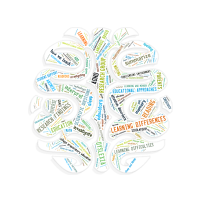

Lab Faculty and Staff
1/8/2019
Reading and the Brain: Part I
Is the human brain hardwired for reading?
What differences exist between the brains of readers with dyslexia and typically developing readers?
What happens in the brain to make fluent reading possible?
These are some of the questions that the Scientific Review Group investigated this past year as we explored the latest research into the neuroscience of reading and dyslexia.
Although a clear cause for dyslexia is not yet known, recent advances in neuroimaging help us understand many of the neurological underpinnings of dyslexia. This first summary highlights some of the important terms used in this research literature.
Despite the fact that none of us is born knowing how to read or write, participation in much of modern American life requires at least basic literacy. No single version of the reading brain is ideal, but there are commonalities in how typical readers process written words. These can be observed as patterns of neuronal activation in distinct areas and pathways. Though understanding differences in the brain does not necessarily provide immediate solutions for implementation in education, learning how atypical readers’ brains function may help reading instructors approach assessment and teaching in new and useful ways.
Before journeying into the complex framework that underlies our ability to read and write, it is important to understand a number of key terms that will likely arise in the upcoming summaries. Neural plasticity is used herein to describe the feature possessed by neurons that allows them to forge new connections between existing points or systems in the brain. Of course, just as a road cannot be scored, paved, and painted overnight (often leading to infuriating standstills), construction of new neural “highways” does not occur without repetition and practice.
In addition to being capable of forging new connections, neurons can also take on new roles in a phenomenon known as neuronal recycling (Dehaene, 2010). So, for example, neurons that were originally used for object recognition may get repurposed or “recycled” for the process of letter recognition when we learn to read.
Evolutionarily, reading is a relatively new skill for humans, and the brain is not “programmed” for reading in the same way that it is for other skills such as face recognition and language. Instead, the brain must recycle neuronal pathways to develop reading skills. Brain imaging studies have helped us understand that specific regions and pathways are more likely to be recruited/recycled for the purpose of reading. Reading recruits many areas of the brain, as we process the words, sentences, vocabulary, emotions (and many other layers of language) embedded in text.
Relatedly, the specialization of neurons or the formation of working groups of neurons devoted to processing particular tasks allows for a child to read more efficiently over time. In fact, Maryanne Wolf’s research group has found that a child’s ability to name objects and, later, letters, predicts “how efficiently the rest of the reading circuit will develop over time” (Wolf et al., 2016). The fact that neurons or groups of neurons can become specialized at a task means that less neural “real estate” is required in order to accomplish the task. This reduction of area needed in the brain is known as progressive focalization (Dehaene, 2010), and importantly, frees other neurons to be “recycled” as discussed above. Moreover, higher-level processes (such as comprehension, in the case of reading) can also begin to take place as automaticity improves.
CITATIONS:
Dehaene, S. (2010). Reading in the brain: The new science of how we read. New York: Penguin Books.
Eden, G., Olulade, O., Evans, T., Krafnik, A., and Alkire, D. (2015). Developmental Dyslexia. In Neurobiology of Language (pp. 815-826).
Norton, E. S., Black, J. M., Stanley, L. M., Tanaka, H., Gabrieli, J. D., Sawyer, C., & Hoeft, F. (2014). Functional neuroanatomical evidence for the double-deficit hypothesis of developmental dyslexia. Neuropsycholgogia, 61, 235-246.
Paulesu, E., McCrory, E., Fazio, F., Menoncello, L., Brunswick, N., Cappa, S. F., ... & Pesenti, S. (2000). A cultural effect on brain function. Nature Neuroscience, 3(1) 91-96.
Pugh, K. R., Landi, N., Preston, J., Mencl, W. E., Austin, A. C., Sibley, D., . . . Frost, S. J. (2013). The relationship between phonological and auditory processing and brain organization in beginning readers. Brain and Language,125, 173-183.
Rutter, M., Caspi, A., Fergusson, D., Horwood, L. J., Goodman, R., Maughan, B., et al. (2004). Sex differences in developmental reading disability: New findings from 4 epidemiological studies. The Journal of the American Medical Association, 291(16),20072012.
Seidenberg, M. (2017). Language at the Speed of Sight: How we Read, Why so Many Can’t , and what can be done about it. Basic Books.
Shaywitz, S. E., Shaywitz, B. A., Pugh, K. R., Fulbright, R. K., Constable, R. T., Mencl, W. E., ... & Katz, L. (1998). Functional disruption in the organization of the brain for reading in dyslexia. Proceedings of the National Academy of Sciences, 95(5), 2636-2641.
Wolf, M. (2010). Proust and the squid: The story and science of the reading brain. Cambridge: Icon Books.


